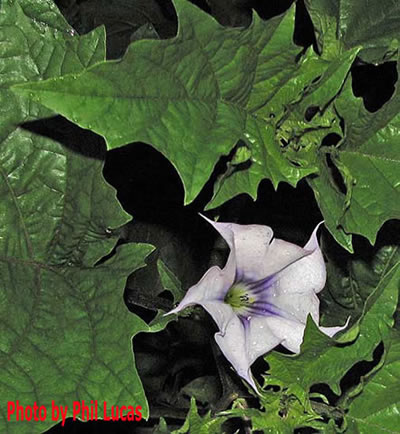From Do It Now
Effects: The phrase "Red as a beet, dry as a bone, blind as a bat, mad as a hatter" has been used to describe Jimson's effects, and it does a good job of summing them up. All parts of the plant are toxic, so pleasant effects are limited-a big reason the plant is used only by novices. Atropine and scopolamine block the neurotransmitter acetylcholine, causing dry mouth, dilated pupils, high temperature (but reduced sweating), and blurred vision. Psychological effects include confusion, euphoria, and delirium.
Side Effects/Risks: Potential for accidental poisoning increases with higher doses. Symptoms include incoherent speech, impaired coordination; rapid heart beat; and dry, flushed or hot skin. In extreme cases, users can experience seizures, intense visual or auditory hallucinations, or cardiac arrest. A Jimson weed overdose should be considered potentially serious and medical intervention sought.
Addiction Potential: Since Jimson weed's effects aren't generally considered pleasurable, addiction usually isn't a factor.
Medical Uses: Because of its anticholinergic properties and antispasmodic effects, Jimson weed was used in traditional medicine to treat a variety of illnesses. Today, extracts are still used in treating asthma, intestinal cramps, and both diarrhea and bed-wetting.
Duration: Depends on dose, with most effects beginning within two hours of use and some lingering up to 24-48 hours.
Legal Status: Jimson weed is not a controlled substance.
Trends: Most Jimson weed use tends to be of the one-time-only thrill-seeking or curiosity variety, typically involving younger teens. Few statistics are available on use but, in 1998, 152 cases of Jimson weed poisoning were reported nationally, according to the American Association of Poison Control Centers.
 Jimson Weed
Jimson Weed